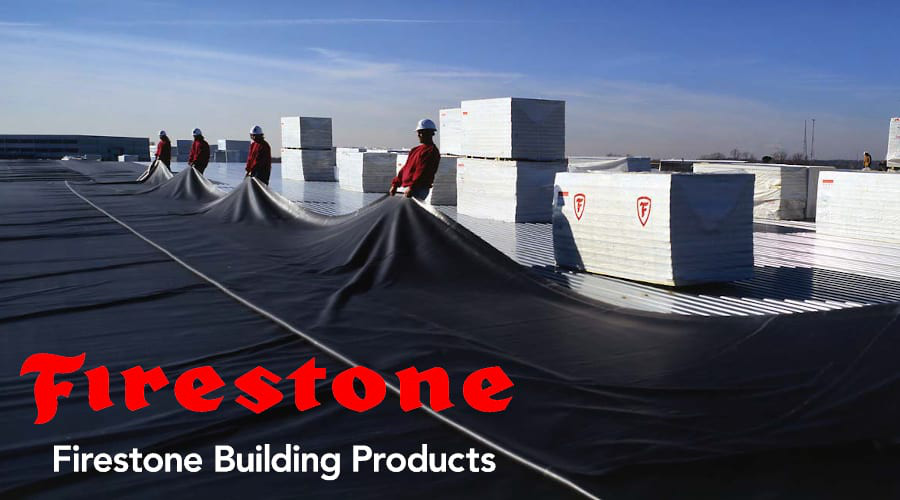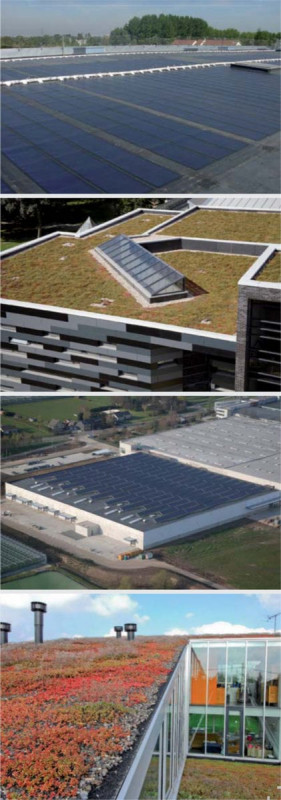The right choice for a sustainable roofing system

Since 1980, Firestone RubberGard EPDM membranes have been installed on hundreds of thousands of roofs from the cold climates of Alaska to the desert sun of the Arabian Gulf. Today, over 1.000.000.000 m² have been installed on rooftops all over the world.
Over the years the EPDM rubber roofing membrane has become the number one single-ply roofing choice of architects, roof consultants and contractors for both new construction, tear-off or recover roofing projects.
Today, major environmental concerns result in a strong commitment, within the building industry, to provide long-term solutions that not only save money by extending the life of the roof but aim to reduce the demand for energy and other natural resources and minimise the environmental impact.
For these ‘sustainable’ roofing systems EPDM membranes are the right choice.
Firestone RubberGard® EPDM is the ideal, highly durable waterproofing solution for low-slope commercial and industrial roofs. Its success can be attributed to a unique combination of features and benefits:
The initial impacts of producing a construction product account for almost all of the environmental impact as compared to the impacts that occur during its service life, until near the end of service life, impacts again rise as the product is removed and disposed. Premature roof failure therefore represents an environmental disaster, when one considers the additional manufacturing, labour, shipping, tear-off and related energy costs necessary to replace a low-slope roofing system.
However, if we can increase the durability of a roof, we not only expand its useful service life, we also reduce the average annual impact on the environment.
The characteristics of the EPDM membrane remain stable and unchanged over time thus providing a sustainable roofing solution.
And … if we can develop and implement strategies to repair or renew the roof, we can even further extend service life, and further reduce average environmental impact.
Even after years of exposure EPDM requires little or no maintenance. Using the QuickSeam Tape System, the EPDM membrane can be repaired at any time during its service life and any additions or alterations to the roof (e.g. PV installations) can easily be addressed using QuickSeam accessories.
The above features (little or no maintenance, facility to repair combined with its inherent durability) and competitive installed cost of EPDM roofing systems result in a very low life-cycle cost, exceeding other popular low-slope roofing systems.

EPDM is an inert material with limited environmental impact during manufacturing, installation and use. The initial production of the membrane has a low embodied energy number (i.e. the amount of energy required to produce and implement a product from material extraction, manufacture and installation). In addition, several other components (cleaners, primers, adhesives) were developed for use with the EPDM membrane, to reduce volatile organic compound (VOC) emissions during installation.
Analysis has shown no toxic substances are released from the EPDM membranes, allowing
collection and use of run-off rainwater for household use. A report from the Belgian BECEWA Institute has lead to the following conclusion: “After exposure to Firestone RubberGard EPDM, the water complies with the basic environmental quality standard for surface water and there is no abnormal germ growth. The water can be used for household use (toilet, washing machine, etc.)”.
Furthermore, at the end of its service life the membrane can be recycled and re-used in e.g. walkway pads and road asphalt. Firestone currently has embarked on an EPDM recycling program.
In regions where Heating Degree Days exceed the Cooling Degree Days, a black EPDM membrane on top of a properly insulated roof can help to save energy and reduce associated carbon emissions. In general, for those buildings where the major part of the energy consumption is used for heating purposes, a black EPDM membrane on top of a properly insulated roof will be beneficial compared to a white reflective membrane.
Ever increasing concerns for the environment make green roofs becoming a regular part of our landscape. EPDM’s ecological benefits, physical characteristics in combination with its life expectancy up to 50 years make it a perfect solution for extensive green roofing applications.
Moreover, EPDM roofing systems can easily be combined with any type of solar panels or photovoltaic strips for solar energy. Solar roofing systems provide savings on energy costs and reduction of carbon emissions helping towards a sustainable environment.
Many factors go into creating a sustainable roofing system, including proper design, quality materials and professional installation in order to achieve great results. EPDM’s excellent and long-lasting performance, its low life-cycle costs and outstanding weathering characteristics, reducing long-term demand on natural resources, make it the best solution for sustainable roofing systems.

EPDM’s sustainability has been proven by extensive testing and various independent studies.
The Firestone RubberGard EPDM membranes have been subjected to artificial ageing by exposing samples in a QUV fluorescent artificial weathering machine. A standard requirement for EPDM membranes demands that no cracks and crazing are apparent after exposure up to 4.000 hours. Firestone membranes have been aged up to 10.000 hours of exposure without any signs of cracking or crazing.
The Firestone EPDM membranes have also been exposed up to 2.000.000 Langley (relating to approx. 20 years of ‘normal’ exposure) in the EMMA test (Equatorial Mounted Mirrors Ageing), where equatorial sunlight is concentrated on the membrane using mirrors, without any signs of ageing.
When considering actual ageing of the membranes in the field, the study, “EPDM Roof Membranes: Long-term Performance Revisited”, written by Tim Trial, Ross Robertson and Brian Gish, found that the tensile strength and tear resistance data obtained for both ballasted and exposed roofs exceed the minimum requirements for new and heat aged membranes after 20-25 years of service life.
To further illustrate the durability of the EPDM membrane, a recent study “Evaluation of the useful life of EPDM roofing membranes”, performed by SKZ (Süddeutsche Kunststoff-Zentrum) in Würzburg, Germany, showed that the useful life of correctly made EPDM roofing membranes may be considered as clearly over 50 years under Central European climate conditions. Although this study puts forward a general conclusion, it gives an indication on what can be expected, based on field experience with EPDM membranes.
The Dutch Institute for Biological and Ecological Constructions (NIBE) publishes, on an annual basis, a comparison between various building products and their impact on the environment. In this survey the roofing materials were evaluated over a calculation period of 75 years. Two major aspects were taken into account: building costs (installation costs per m2) and the hidden environmental costs (emission, raw materials, etc.). Eight basic roofing products were selected and judged. Out of this comparison the EPDM membrane came out as the most environmental friendly product.
An ongoing LCA study, performed by GreenTeam Inc., looks at the impact of various synthetic membranes as well as modified bitumen on climate, atmosphere, water and toxicity. Preliminary results show that, overall, EPDM membranes have less impact on the environment compared to SBS, PVC and TPO membranes. The GreenTeam, Inc. is a strategic and environmental consulting firm specialising in building industry issues, addressing sustainable design and environmental issues.
Earlier, Greenpeace and the magazine “Green Building Digest” have put EPDM membranes at the top of their rankings of ‘low impact membranes’.